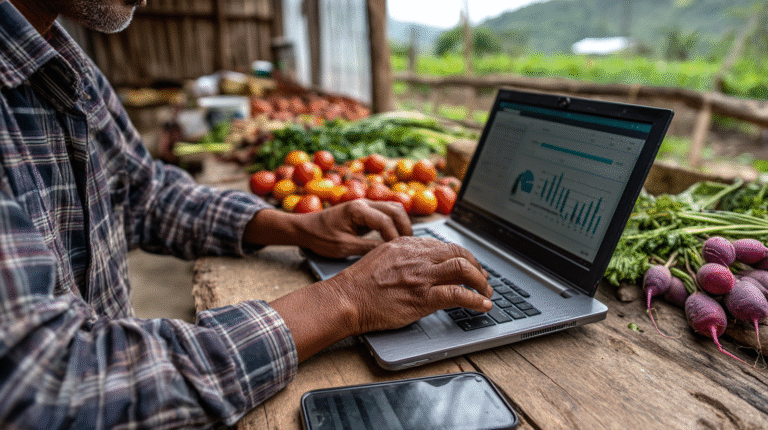Creating Engaging Content to Showcase Your Farm Online
To showcase your farm online effectively, share your authentic story through high-quality smartphone photos of real farm activities, seasonal content, and behind-the-scenes glimpses.
Mix in customer testimonials, highlight your sustainable practices, and demonstrate what makes your operation unique. Post regularly on platforms where your customers spend time—Facebook for community building, Instagram for visual appeal, or TikTok for younger audiences.
The right content strategy turns casual browsers into loyal farm supporters.
Key Takeaways
- Capture authentic farm moments with smartphone photos rather than using generic stock images.
- Share your farm’s unique story through family history, growing methods, and core values.
- Create seasonal content that aligns with your farm’s natural cycles and current harvests.
- Diversify content with behind-the-scenes footage, customer testimonials, and educational videos.
- Track engagement metrics to identify high-performing content and refine your strategy accordingly.
Want to Learn How to Rank #1 in Your Town?
Get the free checklist: “The 5 Quick Fixes to Get Found on Google Maps.”
Understanding Your Farm’s Unique Story and Voice
While stunning photos of your produce might catch someone’s eye, it’s your farm’s unique story that will capture their heart. Your narrative is what transforms customers into loyal advocates.
Think about what makes your farm special:
- Is it family-owned for generations?
- Do you have unique growing methods?
- What values drive your farming practices?
Your story becomes the foundation for engaging farm newsletter ideas. Share anecdotes about:
- That time your tractor got stuck in mud during harvest
- How your grandmother’s tomato recipe inspired your farming journey
- The conservation efforts you’re implementing
Don’t just sell veggies—tell the story behind them. When folks understand why you farm, they’ll connect with your mission on a deeper level.
Consider using themed story elements banners to organize your farm’s narrative visually in both digital and print materials.
Remember that most Americans are three generations removed from agricultural practices, making your storytelling even more crucial for building understanding and trust.
Your authentic voice is your strongest marketing tool!
Essential Visual Elements for Farm Content Marketing
Because humans process images 60,000 times faster than text, your farm’s visual content isn’t just nice to have—it’s essential for connecting with customers. When building your email grower marketing strategy, compelling visuals can transform casual browsers into loyal buyers. Incorporating seasonal themes into your visual content creates a stronger connection with audiences who appreciate timely and relevant agricultural information. For maximum engagement, consider creating pull quotes that highlight customer testimonials or key farming philosophies within your newsletters.
| Content Type | Best Uses | Email Marketing Tips |
| Photos | Product highlights, farm scenes | Feature in weekly availability emails |
| Videos | Harvesting, planting demos | Utilize GIFs or thumbnails linking to full videos |
| Infographics | Growing practices, nutritional info | Break complex info into digestible chunks |
| Behind-the-scenes | Team introductions, field work | Create authentic connection with subscribers |
| Customer stories | Testimonials, recipe sharing | Showcase community around your products |
Don’t overthink this! Even smartphone photos that capture your farm’s authentic spirit will outperform stock images every time.
Crafting Compelling Farm-to-Table Narratives
Since your products already tell beautiful stories, you just need to capture and share them effectively with your audience. Your farm’s journey deserves to be highlighted in your email for small farms strategy.
Share authentic stories about:
- Your daily operations (without glamorizing the hard work)
- The lifecycle of your crops from seed to harvest
- Challenges you’ve overcome (that surprise storm last season?)
Mix in some data that shows your impact:
- Water conservation numbers
- Pounds harvested compared to industrial farms
- Community reach statistics
Don’t worry about being perfect! Your customers want the real you—soil under fingernails and all.
A simple bi-monthly email sharing these stories builds stronger connections than any fancy marketing ever could.
Consider integrating sustainable farming practices like Mariah’s approach of using natural pest control strategies rather than chemical interventions.
Visual storytelling through artwork in farming can powerfully communicate your agricultural practices and connect with your audience on an emotional level.
Leveraging Social Media Platforms for Maximum Reach
Your authentic farm stories and email marketing set the foundation—now let’s amplify your reach through social media!
Choose platforms strategically:
- Facebook for broad community engagement (3B+ users!)
- YouTube for searchable farm tutorials
- Instagram/TikTok for younger customers
Mix up your content to keep followers engaged:
- Daily Facebook updates complement your farm email marketing
- Educational YouTube videos showcasing your expertise
- Behind-the-scenes Reels of morning harvests
Engage actively with your audience by responding to comments on your posts and others’ content to build a stronger farming community.
Post during peak farm audience times—early mornings and evenings work best.
Track what resonates! If those chicken videos get 2x the engagement of your carrot-washing clips, guess what? More chicken content incoming!
Remember: each platform bolsters your email list growth. Add signup links everywhere.
Consider hosting Instagram Live sessions to give virtual farm tours and connect with customers through real-time interaction.
Building and Nurturing Your Online Farm Community
After establishing your digital presence, the real magic happens when you transform followers into an engaged community of farm supporters. Your email list for farms becomes the backbone of this relationship-building effort.
Building a farm community isn’t just about followers—it’s about nurturing real connections with the people who value your harvest.
Start with these community-strengthening strategies:
- Create a Facebook Group where customers can share recipes using your products
- Host monthly webinars teaching seasonal growing techniques
- Send 1-2 emails monthly with product availability and upcoming events
- Share farmer spotlights that tell the personal stories behind your operation
Don’t overthink this!
Even a simple paper signup sheet at your farm stand can build your email list effectively.
The most successful farm communities balance digital connection with real-world engagement. Your customers want to feel connected to their food source.
Consider initiating collaborative marketing efforts with neighboring farms to create a distinctive regional brand that resonates with your online audience.
Respond promptly to customer comments and messages on your social media platforms to provide exceptional customer service that fosters loyalty and encourages repeat purchases.
Measuring Success and Adapting Your Content Strategy
Once you’ve established your farm’s online presence, tracking performance becomes the critical next step in your digital journey.
Setting SMART goals gives you a clear target to aim for!
Are your efforts actually paying off? Time to find out:
- Track email ROI farming metrics like open rates and click-throughs
- Review your conversion rate (visitors who become customers)
- Monitor social engagement (likes, shares, comments)
Don’t just collect data—use it! When you notice your cheese-making videos get 3x more engagement than your product listings, that’s valuable intel.
Determining how your content aligns with your unique farm business requires specific metrics linked to your operation’s goals rather than generic benchmarks.
Make adjustments based on what’s working:
- Double down on high-performing content
- Test new approaches monthly
- Ask customers directly what they want to see
The ROI formula (Benefits – Costs / Costs × 100%) helps you determine if your social media investment is worthwhile.
Small tweaks can lead to big results!.
Related Questions
How Do I Collect Email Addresses From Customers at My Farm Stand?
Utilize a clipboard with sign-up sheets at your farm stand. Offer a small discount or exclusive updates as incentives. You can also create a QR code linking to an online form for easier collection.
What Email Platform Is Best for Small Farms With Limited Tech Skills?
For small farms with limited tech skills, attempt MailerLite or Mailchimp. They offer user-friendly interfaces, drag-and-drop editors, and free plans to start. Both provide simple templates and good customer support for beginners.
How Often Should I Send Farm Update Emails Without Annoying Subscribers?
Send 1-2 emails per month to avoid overwhelming subscribers. You’ll maintain connection without irritation. Stick to a consistent schedule, test different timing, and watch your open rates. Seasonal updates may warrant slightly higher frequency.
Should I Segment My Email List for Different Farm Product Interests?
Yes, definitely segment your list! You’ll see higher engagement when you send targeted emails about specific products customers care about. It’s worth the effort—segmented emails get more opens and drive better results than general blasts.
What Incentives Work Best to Encourage Email Sign-Ups at Farm Events?
Offer early access to seasonal products, exclusive discounts, and free recipes using your farm goods. Limited-time promotions create urgency, while sample tastings paired with sign-up sheets make joining your list captivating during events.
What it all boils down to
You’ve got this! Your farm’s story matters, and sharing it online doesn’t have to be complicated.
Start small, stay authentic, and watch your community grow. Keep in mind perfect photo of your sunrise harvest? That’s content gold!
The digital journey might feel unfamiliar at first, but each post connects someone new to your farm’s mission.
Your best growing season online is just beginning.





